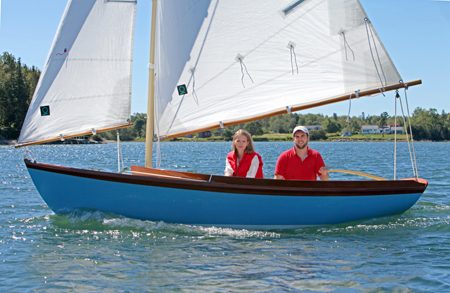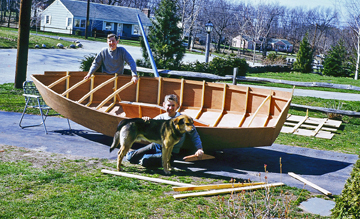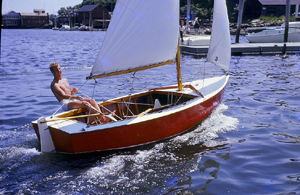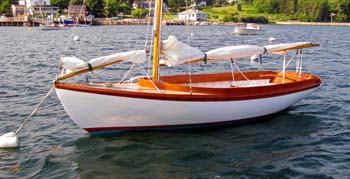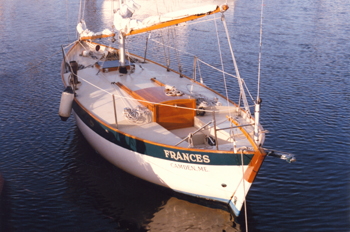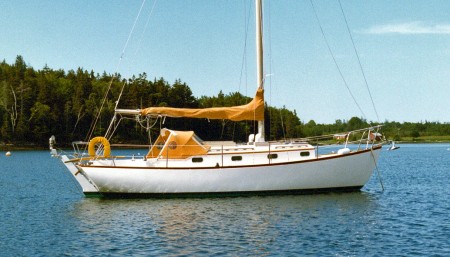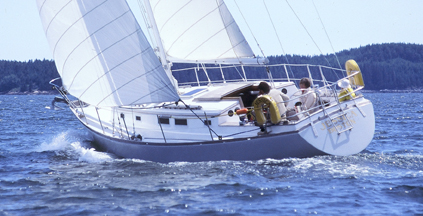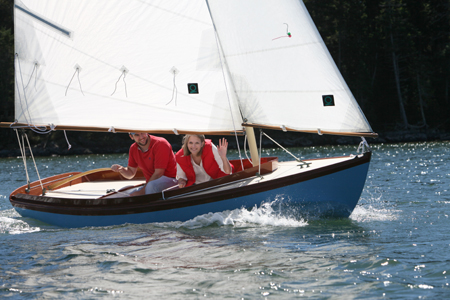THE STATE OF THE YACHT
Some thoughts on yacht design and ownership
By Chuck Paine
As some of you may know my once prolific yacht design business C.W. Paine Yacht Design, Inc. closed in December of 2008. The financial downdraft of 2008 sent many of those who might have become my design clients- and all of my existing ones- scrambling to rescue what was left of their life savings.
The economy has recovered a bit since then thanks to massive money-printing, (our children will inevitably pay for this) and I am back at the drafting table. But I am limiting my efforts to sailboats, small ones at that, and only for my trusted boatbuilder friends rather than the Wall Streeters who tended to be my former patrons.
THE HALCYON DAYS
Looking back on my career I realize how fortunate I was to have ventured into it when I did. My aspiration to design yachts coincided with an unprecedented post-World War II expansion of Northern Hemisphere economies. Before that war the number of people who could afford a yacht numbered in the hundreds. The mass-production of yachts in order to make them more affordable came into being with the advent of fiberglass. Governments and Wall Street expanded the money supply through massive borrowing against the well-being of future generations, and the illusion of economic growth without limit encouraged the wealthy and even the not-so wealthy to purchase my creations.
If you detect a caveat in this sentence you sense correctly. The limits that global warming and resource depletion and debt repayment and the replacement of workers by technology (unemployment) and humane care for the disadvantaged among us will impose upon future consumption are only starting to be dimly perceived. Hence the “Great Recession.”
I believe the yachts of the future will be far fewer in number, far better in quality, and built to last far longer than those of today. They will be made use of more constantly than those of past generations. As will, I believe, all manmade products. Our earth cannot for much longer sustain mass-consumption for its own sake and the day will come when we will be ashamed to have ever willingly called ourselves “consumers”. We are depleting the finite gifts stored within the crust of our planet at an alarming and suicidal rate. Not being suicidal by nature, man will rapidly cease to do so.
SUCKING OUT THE REMAINING OIL
We cannot thoughtlessly continue converting fossil fuels into carbon and depositing it into the atmosphere at anything like the pace we have done in the recent past. Some are saying fracking will save us. And it may well save US. But it merely hastens the day when our children have to survive without this finite and irreplaceable gift that took eons to create and two centuries to squander. The day will come when the burning of our remaining fossil stockpile merely for pleasure (motor-boating) will be considered a serious crime.
This bodes well, of course, for sailboats. I believe it is inevitable that yachts propelled by sustainable energy (wind) will rapidly replace those propelled by our dwindling supply of oil. There is only so much left under the ground, but the wind will blow on forever.
In the future we will rediscover the preciousness of watery marshes and value them more highly than the marinas full of receding rows of unused faded gelcoat that have replaced them. As a hopeless boat lover and the “rainmaker” for my company my first visit to any new city on many a business trip included walking the floats of every marina I could find. With each passing year it became more obvious to me that the majority of these yachts ceased to actually be used. Many of the sailboats would be stripped of their sails, the motorboat bottoms fouled with marine growth from lack of use.
Surely if any resource goes unused past a reasonable length of time it should be ground up into its constituent elements and a new use found for them, and many essentially abandoned mass-produced “yachts” fall into this category. In a world of depleted resources we will have no alternative but to produce far fewer “things”, which last far longer, and find ways to share these less numerous items more equitably so that each of them produces sufficient enjoyment to compensate for the unavoidable environmental damage its construction entails.
HOW YACHT LOVERS WILL LIVE IN THE POST- CONSUMER AGE
An essential reality of yachts is that they are a form of overgrown toy―a toy for those of considerable means, one must admit, but a toy nonetheless. Like all toys, yachts bestow the greatest joy when brand new. While the shelf life of a yacht is a great deal longer than a Barbie Doll or GI Joe, there can be as little joy in owing many a ten-year old “yacht” as there is in owning a much fondled doll a fortnight after Christmas. The monetary value of most such “yachts” passes through the same stages as any other toy, decreasing rapidly to near nil when the other kids on the block all boast of having one just like yours.
I believe- and I know it’s a far from commonly held belief- that in the near future humanity’s entire motivation for economic activity will undergo a revolution. Acquisition and consumption- former motivations for work- will be replaced by an effort to redress the terrible (and terror-ism engendering) disparity between rich and poor. The embarrassing fact is, “We” have far more than enough; “They” are dying of starvation. Only when we have addressed this disparity will the rewards of yacht ownership be justifiable for those who take the lead in bringing about a fairer, safer from terrorism, and more ecologically sustainable world.
LIVING, AND THRIVING, WITH LESS.
In the post-consumption age it will become socially unacceptable to own the piles of mass-produced consumer-crap that spews from Chinese factories through our local big-box stores and into the self-storage villages of Western Civilization. We will cheerfully learn to be happier with less. But while we will own less “stuff”, the stuff we do own less of will be of much higher quality. We will focus our leisure lives around the enjoyment of One Perfect Possession. For some it will be their automobile, bicycle, kite-surfer and for people like me, their yacht. We may end up with only one such possession rather than the scores of unused ones we own today, but it will be a car, bike, board or yacht of the highest quality. Our world of dwindling resources can sustain this one very special possession, especially if we keep and enjoy it for a very long time.
THE WORLD’S MOST EXPENSIVE TEST RIDE
There was a time in the history of dating that you only got the thrill of the test ride after you had signed a contract that ended when death do us part. Likewise in boating. You’d see a sleek beauty on a mooring or at a boat show but you only got to experience her performance after spending hundreds of thousands of dollars and committing to a lifetime of maintenance. I call this, in both cases, “The world’s most expensive test ride”.
These days, not so much. There are still some manufacturers who know how important that “first thrill” is to would-be buyers, and who will not let you get a hand on the tiller until you have signed a contract. But they are becoming few and far between. Increasingly, and rightly, boat buyers are insisting on the test ride before the contract, and builders are finding that if they don’t have a “demonstrator”, they can’t sell their product. In the past, folks who wanted the experience of sailing a fifty-footer, say, had no choice but to buy one or have one built. Today they can charter a boat of the size they are contemplating, put her through her paces in some tropical paradise, and walk away after a week with the thrill ingrained in their memory. Chartering will result in far fewer yachts sitting unused on moorings.
SHARED OWNERSHIP
New ways beyond chartering will emerge for yacht lovers to share ownership. I was a reasonably clever guy who came into a world full of newly prosperous individuals wanting beautiful yachts. Many of these new owners failed to consider how much time out of their working lives could be devoted to actually using them. Surely in the near future some clever lad with a computer will write a computer program that will enable twenty or so would-be yachtsmen to share one very beautiful yacht as if it were solely their own. Websites are springing up (Airbnb) that permit homeowners to share unneeded rooms or second homes in exchange for a fee. It is only a matter of time before yachts will be similarly shared.
There was a time when one needed to own a yacht to see the wondrous turquoise seas of the Caribbean, Seychelles, Society Islands and the nautical world’s many other idyllic destinations. No longer, thanks to the advent of chartering. Many who once owned larger yachts will get their big-boat thrill out of chartering, and their weekend joys from a much smaller daysailor that they keep near their home, or on a trailer in their garage.
MY YACHT OWNING HISTORY
My personal ownership of yachts has travelled a path that I am discovering is well worn by others. I began as a teen who got caught up in the plywood boatbuilding craze of the late ‘50s. My twin and I built our racing bluejay SCRATCH in our parents’ garage in Warwick, RI at the age of 14.
When I was just back from two years in the Peace Corps in 1972 and still in my hippie phase, I decided all I wanted in the world was a Herreshoff 12½. I spent my summer weekends sleeping in the back of my VW van and looking at every available H 12½ between New York City and Maine. I found PETUNIA in a mud creek boathouse on North Haven Island. I have owned PETUNIA for the past 40 years have spent half my life restoring and sailing her.
After I moved to Maine in 1973 and opened my design office I discovered there wasn’t enough work for an unknown neophyte, so I supplemented my meager income by building boats. The first was FRANCES, the 26-foot double-ender whose design I sold to Tom Morris, giving me my start as an independent yacht designer. A four-year, four-yacht boatbuilding binge culminated in a 30-footer, my beloved ANNIE. I had sold that design too to Tom Morris and he generously let me have a hull and deck from his molds at a price I could afford.
Many years later in 2005 my father-in-law Frank passed away, leaving his 39-foot sailing yacht of my design JESSICA to my wife and her siblings. I had fond memories of that boat, having sailed with Frank three times to Bermuda, and during many other summers up fog-enshrouded coasts to the Bras D’ Or Lakes and the St. John River. Nobody wanted the boat no matter how low the price so out of nostalgia I bought her, along with a partner. I put a year of nights and weekends and $50,000 into restoring her.
Then I discovered what so many others have- that I didn’t have time to use a 39-footer. Every summer weekend I had my choice- PETUNIA or JESSICA. The smaller boat won out every time. The choice is a little harder when the 39-footer is your only boat. From what I see in marinas on fine summer Saturdays, the choice then seems to be, to not go sailing. I sold my half of JESSICA to my partner for a small fraction of what I‘d put into her, built an even smaller boat than PETUNIA at a cost of five times what I got out of the much larger boat, and now I sail all the time, alternating between my two small boats. Trading a big yacht that I never found time to use for a small one that I use constantly was one of the best decisions I have made in my life.
ENOUGH ABOUT ME- HOW ABOUT YOU?
I foresee yacht ownership going full circle with renewed interest in small sailing yachts- ones that can be easily gotten going and do not involve huge economic impact to build or maintain. Many sailors are doing just what I did- trading their large and unused cruisers for smaller, nicer yachts that they have time to use. The “daysailor” craze of the present will continue for the simple reason that it makes the most sense for people too busy to spend long stretches of time on the water. The most fun in boating is to be had close to the shore, for it is there that there is a view apart from two shades of blue or gray separated by a straight line. This fact plus a renewed interest in thrift owing to the recession will result in a resurgence of small sailboats. To get your big-boat jags, you’ll charter or yacht-share.
There will always be yachts. In the future we will find ways to make more frequent use of them. The era of mass-production to grind out as many as possible will be replaced by one of artistic competition to create fewer, far nicer ones. Larger yachts will be shared, either through “Seabnb” or chartering.
In all of my musings I am reminded of a story of two men who met at a cocktail party. The Wall-Streeter couldn’t wait to tell the other about his huge home in the Hamptons, his custom-built Bentley, all of the shiny new objects that littered his lawn, and of course his new trophy wife half his age and twice his looks. My patient friend awaited an opening, which finally came after several minutes. “I’ve got something that you’ll never have”, he said.
“Oh, yeah, what’s that?”
My friend answered, “Enough.”
